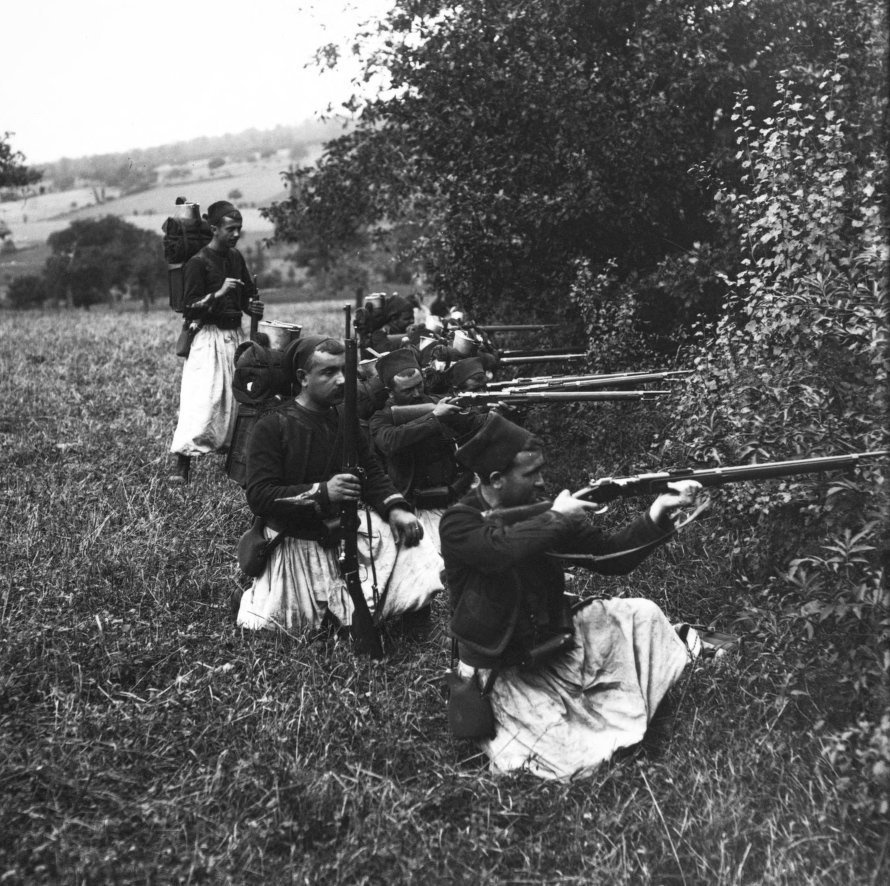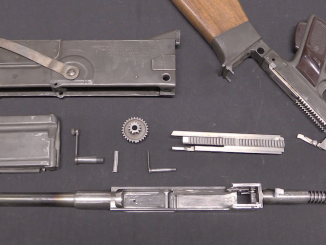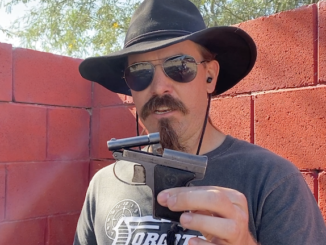
Zouaves on maneuvers with M1886 Lebel rifles, in 1909.

Zouaves on maneuvers with M1886 Lebel rifles, in 1909.

EDIT: Shoot, I managed to get the gear ratio backwards. Sorry! The recoil action provides the necessary delay, and then the gear ratio provides acceleration to ensure the bolt can open reliably, akin to the […]

Today I’m at the BackUp Gun Match in Tucson with a first model Le Français made in 1923. This is an early French semiauto pistol design intended for pocket carry. It has a 7-round magazine […]

I wasn’t really sure what to expect when I opened up John Ellis’ The Social History of the Machine Gun – machine guns and social histories of anything don’t really tend to go together. Ellis […]
© 2025 Forgotten Weapons.
Site developed by Cardinal Acres Web Development.

I think that white pants are even worse that the famous red pants of the french regular troops of 1914 for visual concealment. Of course at the time many (not only the french, austro-hungarian hussards were the worst case) thought that a good tradicional and visually stunning uniform was good for soldiers, helping them to fight with better ”esprit de corps” and ”elan”…using two well kwon french expressions that also resumed the tactics (the french used their own version of the banzai charges in 1914), only some elite light infantry like the Zouaves, the famous Chasseurs or the mountain version, the Chasseurs alpins put some focus on marksmanship and defensive fire.
Funnily enough I would actually prefer to be issued with the white rather than red trousers myself; at least the white ones would get stained by mud and become less conspicuous. Interestingly that was how some of the first camouflage uniforms came about, British and Indian soldiers on the Northwest Frontier would stain their white summer dress uniforms brown. This practice was officially encouraged and eventually pre dyed Khaki uniforms were introduced for campaign dress.
It might interest you to hear that the minister of defence for France from 1904-1911,Henri Maurice Berteaux, did in fact realise how daft it was to go into battle with such conspicuous uniforms and organised trials of a new uniform called la tenue réséda which was grey green in colour without a trace of red in sight. Unfortunately as you mentioned the French senior command was too caught up on notions of élan and felt such dull uniforms could damage moral (I never got the sudden fetish for red trousers seeing as for the better part of four hundred years the French and the Redcoats had been doing their level best to kill one another). Then Henri got killed at a hot air balloon race of all things when a plane made a forced landing on top of him, without a senior government figure pushing for it the French army was only too happy to drop the project and stay with their highly conspicuous uniforms.
As for the Zouaves and other select units having a far saner fighting style I think that can be explained in part by the structure of the French army during this period. Most of the Zouaves and Chasseurs were part of the Armée d’Afrique and although this force was nominally a corps of the metropolitan army it served exclusively in Frances North African Empire and exercised a large degree of autonomy. Apart from the Infanterie Légère d’Afrique Penal units this was mainly a volunteer professional force of career soldiers drawn from the local population (indigenous and colonial) supplemented by other units like the foreign legion. This force was engaged in constant low level insurgency campaigns and so the men had honed their skills as light infantry.
In contrast the French metropolitan army was a conscript force which had seen next to no action since the Franco-Prussian war, a lot of the officers had little concept of modern warfare and had drawn the wrong conclusions from many of the lessons of the last war with Germany. In than war France had been outmanoeuvred, the French military establishment mistakenly concluded that the Germans had won due to a lack of aggression on their part hence the “Banzai” charges, apparently some commanders declined to issue the leading waves ammunition in order to force the men to press the assault home. Thankfully the French were quick learners and by the end of the war they were using tactics which were the equal of the vaunted German storm troopers and would be recognisable today.
Good imput on the white uniforms being the basis for the khaki uniforms, at least in the Boer war it surely save some lives. In 1900 even Kaiser’s troops were in prussian blue uniforms.
About the red pants and other lunacies it was all about the fanatic nationalism of the time, I think. Those réséda uniforms were used in some parade before the war and the public reaction was very bad, IIRC, for them it was simply not a french army uniform. I think that secretely many wanted to see the french army take a revenge on the ”boches” with a uniform very similar of those of the 1870-71 war.
That may be true, but having to wear red pants would hurt my morale.
Ugh, those pants looks like a dress BTW…
My wife saw a Zouave statue at Gettysburg years ago, and asked me “Why were they dressed like elves?”
The reason for the French adopting red trousers was that the dye was the product of one of the colonies. The government wanted to locals to grow the plant that produced the dye as a cash crop, so they could pay taxes (very difficult trying to tax subsistence farmers). However, nobody seemed to want the dye, so to save face the French government bought the entire crop and used it to dye the soldiers’ trousers. I suspect all the talk of Elan and Esprit de Corps came about afterwards to cover their embarrassment.
Eh…no. First the red pant thing is a modification ordened by Charles X (when France was a constitutional monarchy) in 1830 (just a the time of the colonial conquest of Algeria) because he tought that the white pants were too ”napoleonian” and were easily stained.
The dye was named garance in France and it was in fact to promote it’s culture in some rural areas (especially Provence) that it was also adopted.
But in 1869 chemical synthesis of the alizarine was made in…Germany, the product was better and cheaper and this totally killed the garance in a few years. So until 1914 the french have to import it from their former ennemy, wich is not so an irony, in fact the French Republic and the German Empire had good economic relations since the 1880s.
Only the nationalism, IMHO, and all the psychologies associated with it can explain this red pant thing plus the elan and esprit de corps, all very usefull in an ”all attack” spirited army.
In fact many in France, as Kernowboy put it, thinked that in the early 1900s it was now a very bad idea, and from the Boer war to 1914 many propositions were made to change it:
http://rosalielebel75.franceserv.com/reforme-uniforme.html
It’s in french but the pics speak for themselves.
The réséda was the best option but maybe way to germanic and they even have a ”boer uniform” in 1903 !
“Interestingly that was how some of the first camouflage uniforms came about, British and Indian soldiers on the Northwest Frontier would stain their white summer dress uniforms brown.”
They were in fact boiled in kettles/vats of tea, as I recall.
Regarding the “madder red” French uniform trousers, I believe they were first adopted to utilize domestically produced aniline(?) die. It was at first an economic decision which later morphed into a matter of esthetics.
Ah…and the Lebel. Of course it’s days as a innovative rifle were long gone, as for the 8mm lebel cartridge with it’s (now) strange Bordeaux wine bottle neck only famous during a few years to be the first military mass adopted smokless cartdrige.
But one thing that many modern gun enthousiast usually forget, only focusing about ”what is the best to fire” or the fact that Lebels have tubular magazine, it’s that soldiers want reliability, especially in horrendous conditions of the trench war, and nearly obsolete Lebel proved to have tons of it.
…I wonder how many of the folks of the pic survived not the whole war but yet only the first months of war…
There’s also firepower superiority to consider, which in the rifle department was pretty much on the Allied side;
Mauser; 5 shot
SMLE; 10 shot
Lebel; 8 shot
Some Mausers issued to snipers were fitted with an extended 20-shot magazine, but those were rare.
In a straight-up fight, a British or French infantry section could send more lead downrange without stopping to reload than a German one could.
The Germans probably did the math on this early on, which would at least partially explain their emphasis on heavy machine guns. Although the volume of fire they received from the British during the Mons retreat seems to have surprised them.
cheers
eon
The tubular magazine of the Lebel is pretty slow to reload; probably slower than most lever-actions with a tubular magazine. So, after the initial contact the Mauser probably had an upper hand in practical rate of fire.
About heavy machine guns: all sides of the war started with much fewer machine guns than what was soon shown to be needed. The British professional soldiers could compensate with their “mad minute” training, but it was soon clear that the new wartime recruits could not be trained to the same standards in a reasonable amount of time. The Germans had more machine guns than the Allies, but not enough for the trench warfare that followed.
You forgot about French Berthier rifle with only 3-round magazine or 5-round magazine. But there was still a lack of rifles – French army ordered single-shot Remington Rolling Block rifles in their 8x50R chambering.
The 1916s version of the Berthier (the one with 5 rounds mag) started slowly to replace the Lebels in front line units. In 1917-18 the increase of firepower of the french batallions (more chauchats, 37mm infantry gun, berthiers, mortars, grenades, much more machine-guns) would have deeply impressed any soldier from 1914. Basically the ”section” (squad) was build around the chauchats and the rifles transformed in ”VB” grenade launchers, then the guys who carried all the ammo were armed with those funny pre-war rifles 😀
I find a subtle irony in an army equipped with an 8 round capacity rifle, which is slow to reload, and a 3 round capacity carbine which can be reloaded almost instantaneously.
About the strange shape of this cartridge :
It’s because the use of a maximum of part of the Gras system’s bolt(to spare money).
The external diameter of the 8mm cartigde’s bottom is the same thant the 11mm Gras.
The 8mm Lebel was derived from 11mm Gras and hence the Hotchkiss 1914 designed for 8mm Lebel can be build in 11mm Gras for anti-balloon use (far ancestor of modern big-bore AA machine guns). The Vickers machine gun also have their 11mm version.
The shape of 8mm Lebel also caused flaws in Chauchat machine guns, due to their shape the magazines are half-moon in shape. Chance of jam of cartridge in curve magazine is greater than in straight, especially if magazine is dirty.
French Army considered before 1914 that 8mm Lebel is obsolete so the Meunier semi-auto rifle (and cartridge) was developed. Production was started but when the war broke out the French Army was no rearmed yet, so the production of Meunier was cancelled for sake of logistic simplicity.
If one replaced the Labels with hammered cap-n-balls it could be 1861-1862 and the American Civil War.
Look up some historical photos of the siege of Vicksburg and the final lines around Richmond during the American Civil War. If not for the rifle-muskets and lack of helmets, you could be looking at Flanders in 1915-16.
Of course there was no barbed wire because it hadn’t been invented yet. But the number of chevaux de frise and trenches with thickets of sharpened wooden stakes in front of artillery redoubts and trenchlines more than made up for the lack.
cheers
eon
Since you mentioned artillery, that would be one obvious difference. The ACW artillery pieces had more common with Napoleonic era than WW1 artillery pieces. The development of artillery technology between 1865 and 1914 was as great if not greater than the development of small arms technology. The most advanced WW1 artillery pieces such as the French 155mm GPF mle.1917 could be used in combat today (it’s shorter ranged than modern 155mm guns, but its range of 19 kilometers would still be adequate).
True. But as Ian Hogg points out in The Guns 1914-18, early on all the combatants were short of modern artillery simply because they never anticipated the attrition rate they would suffer, and also because their pre-war production plans anticipated a short “war of movement”, rather than a prolonged slogging match of positional combat.
The French probably had it worst, as evidenced by the use of the old non-recoil 122mm howitzer, and 22 and 28 cm fortress guns in field positions. Even with iron versions of garrison carriages, these elderly breechloaders were barely more advanced that those used in the 1860s.
cheers
eon
The shortage of artillery pieces really forced the French to use a lot of guns from the 1870s, including the 90mm, 120mm and 155mm De Bange guns and the 95mm Lahitolle gun, in addition to the ones you already mentioned. They all had “Napoleonic” rigid carriages without a recoil buffer, but they did have two very important advances over the ACW artillery: they had real steel barrels (instead of iron or bronze) and they were breech loading. These advances put them in a different league when it came to range and rate of fire, although the latter was still limited by the need to reposition the gun after each shot.
They could also be significantly modernized by placing them on a modern carriage with a recoil system. That was done to some of the 155mm De Bange guns in France during and after WW1 and to the 120mm guns in Poland between the world wars. The resulting guns were still sufficiently up-to-date even by WW2 standards. In contrast, no modernization of the 1860s muzzle loading artillery pieces could have made them acceptable in WW1; they would have been as obsolete as muzzle loading caplock muskets.
Arrêtez! Le temps de marteau!
Hilarant!
Vous ne pouvez pas toucher cela!
@Doc,
Mais…. Ça ne veut rien dire?!? 😀
Avant votre temps, peut-être. Référence des années quatre-vingt.
I think this picture may actually have been taken in France, though the soldiers are without a doubt Zouaves.
Apparently in 1899 each Zouave regiment was ordered to raise a fifth battalion for home service in France itself. Two of these battalions were stationed in Lyon and another two in Paris, there purpose was apparently to each form the nucleus of four new Zouave regiments to be raised in the event of a general war, in addition they were also based in France to foster better links between the African and Metropolitan armies. I suppose if you were being cynical you could note that there was certain logic in garrisoning the capital with two battalions recruited from overseas Frenchmen, in the event of any civil unrest their loyalties would be far less suspect than any local conscripts.
Therefore its more than likely that the soldiers in this picture are from one of those units.
These men would probably be quite chuffed with themselves, instead of serving their term of service in some desert fort somewhere in the Algerian interior hunting down Ghazis, they get to go on leave in either Paris or Lyon and impress the local’s with a snazzy exotic uniform.
It could be either from metropolitan France or French North Africa. The lushness of the nature does not rule out the latter, because the coastal areas between the Atlas mountains and the Mediterranean receive plenty of rain during the autumn and winter, and make good farmland.